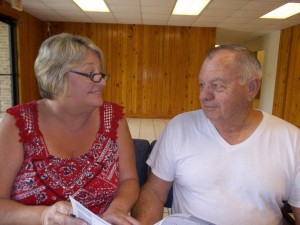by Monica Brinkley | Apr 23, 2013
Se lf-control is an important skill for all children to learn. In other words, individuals know right from wrong or have power to control their own actions. Self-control is the ability to think before you act, rather than being controlled by your feelings. Children who rely on parents or other children to make choices for them do not learn self-control.
lf-control is an important skill for all children to learn. In other words, individuals know right from wrong or have power to control their own actions. Self-control is the ability to think before you act, rather than being controlled by your feelings. Children who rely on parents or other children to make choices for them do not learn self-control.
Often times, these children may follow others’ bad choices and not take responsibility for the consequences of their behavior. When the child is young, this causes many frustrations. As they grow, the problems can grow as well and the consequences can become more and more serious, even leading to self-destructive behavior like the use of drugs and alcohol. Therefore, it is very important to start young to build the skills that children will need later in life.
Self-control lessons start in the first year of life, but it is never too late to help a child build more self-control. Research shows that when you respond predictably to an infant who cries, later on that baby is likely to cry less rather than more. So you need to get to know your baby’s style of soothing.
Toddlerhood is a demanding time for parent and child. Many toddlers become frustrated because they may have trouble making themselves understood or may be too little to do the things they want to do. Expect toddlers to have little self-control.
Children behave best by keeping them on a regular schedule as much as possible. Help them get enough rest and serve regular meals and snacks. At this age, children are very distractible – you can redirect them to another activity when they are doing something unsafe. If your child has a temper tantrum, make sure they are safe and keep them from hurting themselves or others. After the tantrum is over, they need comfort and support. Teach some basic words, such as NO and STOP, to use in difficult situations. The goal of self-control at this age is to help children begin to use words to express themselves.
During the preschool years, children are eager to play with others their own age, but it is rarely smooth. The goal of this stage of development is to learn how to talk about a problem and solve it with words rather than aggressions. Encourage children to say what the problem is and ask them to come up with ideas for a solution. As long as all the children involved agree, let them try out their own solutions.
This is the time to introduce family chores. Simple jobs like setting the table and putting away laundry are good for children at this age. Research has found that children who have regular chores from the age of four are more successful in early adulthood.
The work of helping your child build self-control continues through the elementary school years and into the teen years. Children learn to be responsible by handling homework, family chores, and obligations to friends and family. Starting early and carrying on self-control lessons throughout your child’s developing years is the best way to give the gift of healthy self-control.
by Heidi Copeland | Jan 29, 2013

Family traditions bind us together.
According to the Free Merriam-Webster On-line Dictionary, there are countless definitions of family. Perhaps, one definition that most could agree on is that a family is a group of people united by certain convictions or a common connection.
Don’t let the pressures of this hectic and ever-changing holiday season (or any of life’s changes for that matter) affect a positive family balance. Try to make the most of your family relationships and build meaningful traditions. Traditions are the glue, the true and lasting bond that unite families with a sense of belonging, continuity, and routine that family members can depend on year after year, generation after generation.
If you don’t have any family traditions…don’t get overwhelmed.
Suzanna Smith, Associate Professor, Human Development and Family Life, Department of Family, Youth, and Community Sciences, University of Florida, provides a great publication that lists characteristics that build strong and resilient families. (Publication #FCS2057)
Listed are her ideas plus an example to get you started.
1. Focus on commitment to each other. Committed families provide a sense of safety and security that say we belong. Designate time exclusively for family.
2. Respect values, physical, spiritual, and emotional wellness. A family environment is complex and involves many factors. As a family, decide what to do to help promote your family values. Board games anyone?
3. Encourage effective family communication. Practice positive speaking. Communication is not just talking. Practice a flexible approach to listening, talking, and reacting. Positive speaking focuses on the things we value most. Example…. “I love that you are a considerate person.”
4. Promote appreciation of all family members. Celebrate the wonderful qualities of those people you care about most. In the words of Mother Teresa, “There is more hunger for love and appreciation in this world than for bread.”
5. Providing meaningful and sufficient time together. An effective way to build the skill of time together is to learn to share stories about your family. These stories can be a means of conveying the caring and tradition of your family system. Try eating family meals together, without distraction, as often as possible.
6. Offering effective strategies to deal with stress. Learn to recognize the signs of tension and do something positive to deal with it. Physical activity of any kind is shown to work wonders here. Go for a walk, get up and stretch, or just remove yourself from the situation.
Make time this season to review or build some new, strong, and resilient family traditions of your own. And remember, there are no rules and there is no “right” way to do this. Building family strengths (traditions) helps families solve problems, adapt to change, and have fun!
For more information, visit EDIS – the Electronic Data Information Source of UF/IFAS Extension, a collection of information on topics relevant to you. http://edis.ifas.ufl.edu/departments/fycs.html
by Monica Brinkley | Apr 26, 2012
 As I begin to age, I am finding that many of my co-workers, friends and I are dealing with aging parents. Often times, it is trying and difficult to communicate with aging family and friends. Hopefully, this article with give you some tips that will make talking with older adults just a little easier.
As I begin to age, I am finding that many of my co-workers, friends and I are dealing with aging parents. Often times, it is trying and difficult to communicate with aging family and friends. Hopefully, this article with give you some tips that will make talking with older adults just a little easier.
Three simple words can help you talk to the older adults in your life: stop, look, and listen. These words are important when you are in everyday conversation. But they are even more important when you are trying to solve a problem or get essential information. It only takes a little time to stop, look, and listen. When you do, you will quickly find that you will feel less stressed. Also, your older friend or family member will feel less frustrated and more understood.
Stop what you are doing and focus on your conversation. Of course, we talk to each other while we are doing other things. Talking while we do the dishes or drive the car is normal. Those are good times to talk about the weather, folks we visited with last weekend, or how cute our grandchildren are. But it’s different when we want to talk about something important. When we want to ask about a problem or be sure someone understands, we must stop, look, and listen. When we don’t stop what we are doing, our older friend or family member may not hear or understand us. We also may miss important nonverbal messages they are sending. For example, while coming out of the doctor’s office, you may quickly ask what the doctor said, but you also may be thinking about what you need at the grocery store. Take the time to stop and ask about the doctor’s comments before moving on. Focus on the appointment and ask for details while the information is fresh on your older family member’s mind.
Look at the older person when you are talking to them. Looking directly at a person lets them know we are paying attention and that we care about what they have to say. Because many older adults have some hearing loss, they hear better when they can look at the person who is talking. Without realizing it, most of us increase our hearing by reading lips. It is easier to read lips when the listener can clearly see the speaker’s face. So face the person you are talking to, avoid eating or drinking while you are talking, and be sure to speak in a strong, clear voice.
Listen with more than your ears. Listen for more than the words. Listen for unspoken messages. What is your older relative or friend telling you with his or her body language? Listen for the person’s tone of voice—is he or she angry, sad, scared, or excited? Listen for the message you see in the older adult’s face or posture. Listen with your ears, your eyes, your mind, and your heart.
Three simple words can prevent many misunderstandings. When we stop, look, and listen, we are showing our older relative or friend that we not only care, but also want to understand and to help. These three simple words are just the start of better communication.
Source: Stop, Look, and Listen: Tips for Talking to Older Adults, Carolyn S. Wilken, associate professor, Department of Family, Youth and Community Sciences, Florida Cooperative Extension Service, Institute of Food and Agricultural Sciences, University of Florida. Please visit the EDIS Web site at http://edis.ifas.ufl.edu.
 lf-control is an important skill for all children to learn. In other words, individuals know right from wrong or have power to control their own actions. Self-control is the ability to think before you act, rather than being controlled by your feelings. Children who rely on parents or other children to make choices for them do not learn self-control.
lf-control is an important skill for all children to learn. In other words, individuals know right from wrong or have power to control their own actions. Self-control is the ability to think before you act, rather than being controlled by your feelings. Children who rely on parents or other children to make choices for them do not learn self-control.

